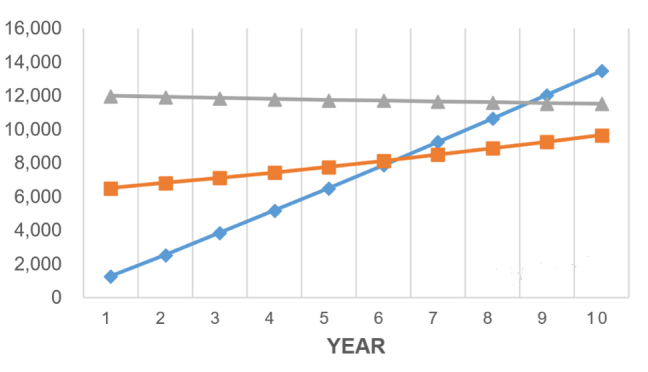The application of wind and solar storage systems in the power grid can be divided into three parts: the power generation side, the power grid side, and the user side are indispensable for achieving energy transformation. The development of the power generation side and the power grid side relies more on the driving force of enterprises, regional policies and countries. , And user-side development in addition to policy mandatory requirements, whether it can bring benefits is the basis for users' most intuitive judgment. Although there is ample room for growth on the user side and it is also the focus of future development in many countries, it is difficult to implement, especially for regions with low electricity prices, slower green energy development, or insufficient policy capabilities, such as Taiwan. To develop renewable energy on the user side, users must first understand how to use it and its advantages and disadvantages. At present, there are generally two applications of solar wind storage systems on the user side. Save contract capacity. These two application modes will bring benefits to users in countries with high electricity prices, such as Germany and Japan. Below we will take Germany as an example to analyze the economic benefits that German household energy storage can bring.
High European electricity prices bring momentum to its residential energy storage market
At present, the average electricity price in European countries is above 20 €ct/kWh, and in Germany it is as high as 31 €ct/kWh. In the past 10 years, the price of household electricity in Germany has risen from 20 €ct/kWh by more than 50% to 31 €ct/kWh. The structure and proportion have three parts. One is the actual cost of electricity production (22.4%), the second is the cost of the power transmission network (25.1%), and the third is levies, taxes and taxes (52.5%). Through analysis, we can also understand the main reasons for the increase in electricity prices as follows: 1. Renewable energy surcharges; 2. Grid fees. Due to the rapid rise of various types of renewable energy sources, the power grid must be more difficult to dispatch, and appropriate expansion and transformation of the grid must be carried out; 3. Electricity value-added taxi. As the proportion of renewable energy continues to increase, electricity prices will continue to increase, and this also lays a solid foundation for the development of German household optical storage systems.
With high electricity prices and policy systems, the German residential solar storage system has already achieved economic benefits
The equipment price of a small solar storage system is high, and the unit cost can even be twice that of the power generation side. The picture below shows the price trend and forecast of the German household solar storage system. The current unit price of solar and energy storage systems is about 1,250 €/kWp and 700 €/kWh. Based on this price, we assume different scenarios to analyze how much economic benefits German households can bring if they install optical storage systems.
Taking a general household as an example, the average power consumption is 4000 kWh/year, and the solar power generation hours are 1200 hours/year. Case 1 is no solar storage system installed, Case 2 only installs solar energy (5 kWp), and Case 3 installs solar energy ( 5 kWp) + energy storage (10 kWh). At the same time, according to German policy, the installation of energy storage systems above 3 kWh can receive 500 € subsidies (for each additional 1 kWh, another 100 € will be provided, up to 3200 €), and the FIT price is 10 € ct/kWh. The annual electricity expenditure comparison is shown in the figure below:

The accumulated electricity expenditures for the three cases in 10 years are about 13,500, 9,700, and 11,500 € respectively. Only installing solar energy can save about 28% of the cost, and installing solar + energy storage can save 14.5% of the cost. The results show that the benefits of installing solar + energy storage are not significant. This is due to several reasons. One is that the price of energy storage system equipment is still too high, and the other is that the ratio of solar storage capacity to electricity consumption has not been optimized. After optimizing these two factors, it is expected that the household optical storage system in Germany after 2025 can save more than 50% of the household’s expenditure on electricity per kilowatt-hour.
From: InfoLink

Sweep the official account